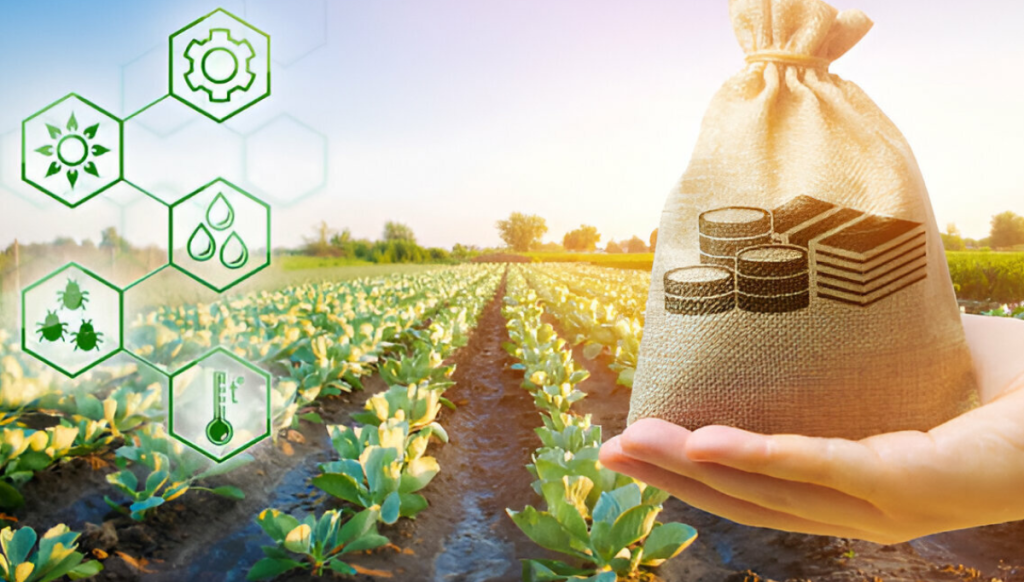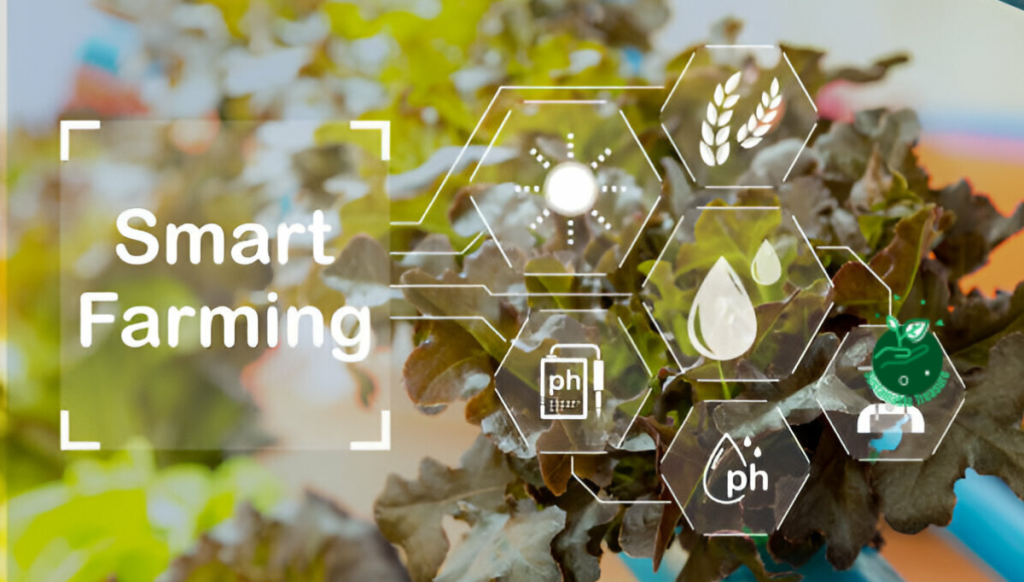Table of Contents
As our planet grapples with the pressing challenges of climate change, environmental degradation, and food insecurity, it has become increasingly evident that our current agricultural practices are unsustainable.
The conventional model of intensive farming, which relies heavily on synthetic inputs and monocultures, has not only contributed to soil depletion and biodiversity loss but also exacerbated the emission of greenhouse gases. Fortunately, a paradigm shift is emerging, and regenerative agriculture is leading the way toward a more sustainable and resilient food system.
Regenerative agriculture is a holistic approach to farming that focuses on revitalizing the entire ecosystem, from the soil to the surrounding environment.
By implementing regenerative practices, farmers can not only improve soil health and enhance biodiversity but also sequester carbon from the atmosphere, mitigating the impact of climate change.
This approach represents a fundamental departure from the extractive and resource-intensive model of conventional agriculture, offering a promising solution to the pressing challenges we face.
Understanding Regenerative Agriculture

At its core, regenerative agriculture is rooted in a deep respect for the intricate relationships that exist within natural systems. It recognizes that the health of the soil is inextricably linked to the well-being of plants, animals, and ultimately, human communities.
By prioritizing soil regeneration through practices such as no-till farming, cover cropping, and crop rotation, regenerative agriculture aims to rebuild the complex network of microorganisms and organic matter that support soil fertility and structure.
One of the key principles of regenerative agriculture is the promotion of biodiversity. By encouraging a diverse array of plant and animal species on the farm, farmers can create a more resilient ecosystem that is better equipped to withstand environmental stresses and pests.
This approach not only enhances the overall health of the farm but also contributes to the preservation of valuable genetic resources for future generations.
Regenerative agriculture also emphasizes the importance of minimizing external inputs and relying on natural processes as much as possible.
This could involve techniques such as using compost and manure instead of synthetic fertilizers, practicing integrated pest management, and incorporating agroforestry and permaculture designs to create self-sustaining systems.
The Case for Investing in Regenerative Food Systems
As the world grapples with the mounting challenges of climate change, water scarcity, and food insecurity, the urgency to transition towards more sustainable and resilient food systems has never been greater.
Investing in regenerative agriculture offers a compelling solution that addresses these issues while simultaneously generating economic opportunities and fostering social impact.
From an environmental perspective, regenerative practices have the potential to significantly reduce carbon emissions and even actively sequester carbon from the atmosphere.
By improving soil health and increasing organic matter content, regenerative agriculture can transform farmlands into carbon sinks, effectively mitigating the impacts of climate change. Additionally, these practices promote water conservation, enhance biodiversity, and reduce reliance on synthetic inputs, further contributing to environmental sustainability.
Economically, regenerative agriculture holds the promise of increased profitability and resilience for farmers. By reducing input costs and improving yields over time, regenerative practices can lead to higher net returns and a more stable income stream.
Furthermore, the growing consumer demand for sustainably produced food creates new market opportunities for regenerative farmers, potentially commanding premium prices for their products.
| Regenerative Practice | Environmental Benefit | Economic Benefit |
|---|---|---|
| No-till farming | Reduces soil erosion, sequesters carbon | Lowers fuel and labor costs |
| Cover cropping | Improves soil fertility, increases biodiversity | Reduces need for synthetic fertilizers |
| Crop rotation | Disrupts pest and disease cycles | Enhances long-term yields |
| Agroforestry | Sequesters carbon, provides habitat | Diversifies income streams |
From a social perspective, investing in regenerative food systems can contribute to improved food security, particularly in vulnerable communities.
By fostering resilient and localized food production, regenerative agriculture can help mitigate the impacts of climate change on food systems and ensure a stable supply of nutritious food for all.
Impact Investing: Aligning Profit with Purpose
As the demand for sustainable and ethical investment opportunities continues to rise, impact investing has emerged as a powerful tool for aligning financial returns with positive social and environmental outcomes.
In the context of regenerative food systems, impact investing offers a compelling avenue for channeling capital towards sustainable agriculture practices while generating attractive returns for investors.
Impact investors actively seek out investment opportunities that have the potential to create measurable and scalable positive impacts on pressing global challenges, such as climate change, food security, and environmental degradation.
By investing in regenerative agriculture projects, investors can directly support the transition towards more sustainable and resilient food systems while also generating financial returns.
One of the key advantages of impact investing in regenerative food systems is the ability to unlock new sources of capital for sustainable agricultural initiatives.
Traditional financing sources, such as banks and conventional investment funds, may be hesitant to invest in regenerative agriculture due to perceived risks or a lack of understanding of the model.
Impact investors, on the other hand, are driven by a dual mandate of generating financial returns and creating positive social and environmental impacts, making them well-suited to support these innovative and transformative approaches.
Opportunities in Regenerative Agriculture Investment
The investment landscape in regenerative agriculture is diverse and offers a range of opportunities for investors with varying risk appetites and return expectations. Here are some promising areas for consideration:
- Farmland Investment: Investing in regenerative farmland can provide stable long-term returns while supporting the transition towards sustainable agricultural practices. This could involve purchasing land and leasing it to regenerative farmers or investing in farmland investment funds focused on regenerative agriculture.
- Agroforestry and Perennial Crops: Agroforestry systems, which integrate trees and shrubs with agricultural crops, offer opportunities for carbon sequestration, biodiversity preservation, and diversified income streams. Investing in agroforestry operations or perennial crop plantations, such as nut orchards or berry farms, can generate attractive returns while contributing to environmental sustainability.
- Value-Added Processing and Distribution: As the demand for regeneratively produced food continues to grow, there are investment opportunities in value-added processing facilities, such as organic mills, food hubs, and distribution networks that specialize in connecting regenerative farmers with conscious consumers.
- Regenerative Agriculture Technology and Innovation: The field of regenerative agriculture is continuously evolving, driven by technological advancements and innovative practices. Investing in companies developing sustainable agricultural technologies, such as precision farming tools, soil monitoring systems, or regenerative seed varieties, can provide exposure to this high-growth sector while supporting the adoption of sustainable practices.
- Regenerative Agriculture Funds and Impact Funds: For investors seeking diversification and experienced management, investing in dedicated regenerative agriculture funds or broader impact funds with a focus on sustainable food systems can provide exposure to a portfolio of carefully vetted regenerative agriculture projects and companies.
When evaluating investment opportunities in regenerative agriculture, it is crucial to conduct thorough due diligence, assess the potential for both financial returns and positive environmental and social impacts, and consider the long-term viability and scalability of the project or venture.
Risks and Challenges
While investing in regenerative food systems presents significant opportunities, it is essential to acknowledge and address the potential risks and challenges associated with this emerging field.
One of the primary challenges is the perceived higher risk profile of regenerative agriculture projects, particularly during the transition phase from conventional practices.
- Market Volatility and Pricing Risks: As with any agricultural venture, regenerative agriculture projects are subject to market volatility and fluctuations in commodity prices. Additionally, there may be uncertainties surrounding the pricing and demand for regeneratively produced goods, particularly in regions where consumer awareness and market infrastructure are still developing.
- Regulatory and Policy Uncertainties: The regulatory landscape surrounding regenerative agriculture practices and sustainable food systems is rapidly evolving. Changes in government policies, subsidies, or certification standards can impact the viability and profitability of regenerative agriculture projects.
- Long-Term Commitment and Transition Challenges: Transitioning from conventional to regenerative agriculture practices can be a multi-year process, requiring significant upfront investment, patience, and a long-term commitment from both farmers and investors. The potential for delayed returns during the transition phase can deter some investors.
- Scalability and Adoption Challenges: While regenerative agriculture has gained momentum, widespread adoption and scaling of these practices remain a challenge. Factors such as farmer education, access to technical assistance, and infrastructure constraints can hinder the rapid scaling of regenerative agriculture projects.
To mitigate these risks, it is essential for investors to conduct thorough due diligence, diversify their portfolios across various regenerative agriculture projects and invest in companies or projects that have a robust risk management strategy in place.
Additionally, investors should stay informed about the evolving regulatory landscape and engage with policymakers to advocate for supportive policies and incentives that can accelerate the adoption of regenerative agriculture practices.
Strategies for Successful Investment
Investing in regenerative food systems requires a strategic approach that takes into account the unique characteristics and challenges of this emerging field. Here are some key strategies to consider for successful investment in regenerative agriculture:
- Diversification: Diversifying your investment portfolio across various regenerative agriculture projects, ranging from farmland to value-added processing facilities, can help mitigate risks and ensure a balanced exposure to different sectors and business models.
- Patient Capital and Long-Term Commitment: Regenerative agriculture projects often require a longer time horizon to realize their full potential. Investors should be prepared to commit patient capital and take a long-term view, as the benefits of regenerative practices may not be immediately apparent.
- Thorough Due Diligence: Conducting comprehensive due diligence is crucial when evaluating regenerative agriculture investment opportunities. This includes assessing the management team, business model, financial projections, environmental impact, and alignment with regenerative principles.
- Stakeholder Engagement: Engaging with various stakeholders, such as farmers, local communities, policymakers, and industry experts, can provide valuable insights and support the successful implementation of regenerative agriculture projects.
- Impact Measurement and Reporting: Establishing robust frameworks for measuring and reporting on the environmental, social, and financial performance of regenerative agriculture investments is essential for transparency and accountability.
- Collaboration and Knowledge Sharing: Fostering collaboration and knowledge sharing among investors, farmers, and other industry players can accelerate the adoption of best practices and drive innovation in regenerative agriculture.
By adopting a strategic and informed approach, investors can navigate the complexities of the regenerative agriculture landscape and position themselves for long-term success while contributing to the transition towards a more sustainable and resilient food system.
Impact Measurement and Reporting
As impact investing in regenerative food systems gains momentum, the importance of measuring and reporting on the social and environmental impacts of these investments becomes paramount.
Investors, stakeholders, and consumers alike are increasingly demanding transparency and accountability to ensure that regenerative agriculture projects are delivering on their promised benefits.
Several frameworks and tools have emerged to assist in measuring and reporting the impact of regenerative agriculture investments. Some of the widely recognized approaches include:
- The Sustainable Agriculture Matrix (SAM): Developed by the Sustainable Food Lab, the SAM provides a comprehensive framework for assessing the environmental, social, and economic sustainability of agricultural operations. It evaluates factors such as soil health, water use, biodiversity, worker welfare, and profitability.
- The Cool Farm Tool: This online calculator, developed by the Cool Farm Alliance, enables farmers and investors to estimate greenhouse gas emissions, carbon sequestration, and the overall carbon footprint of agricultural operations.
- The Regenerative Organic Certification (ROC): Administered by the Regenerative Organic Alliance, the ROC is a robust certification program that evaluates agricultural operations based on their adherence to regenerative organic principles, including soil health, animal welfare, and social fairness.
- The Global Impact Investing Rating System (GIIRS): GIIRS is a comprehensive rating system that assesses the social and environmental performance of companies and funds, including those operating in the regenerative agriculture sector.
By adopting these frameworks and tools, investors can quantify and communicate the positive impacts of their regenerative agriculture investments, such as carbon sequestration, soil health improvements, biodiversity preservation, and social benefits to local communities.
It is important to note that impact measurement and reporting should not be a one-time exercise but rather an ongoing process that involves continuous monitoring, evaluation, and adaptation.
Regular reporting and transparent communication with stakeholders can build trust, demonstrate accountability, and inspire further investment in regenerative food systems.
Case Studies: Success Stories in Regenerative Agriculture
To better understand the transformative potential of regenerative agriculture, let’s explore some real-life success stories that showcase the positive outcomes for farmers, communities, and the environment.
- Gabe Brown’s Regenerative Ranch in North Dakota: Gabe Brown, a pioneering regenerative farmer from North Dakota, has successfully transitioned his 5,000-acre ranch from a conventional, chemical-dependent operation to a thriving regenerative system. By implementing practices such as no-till farming, cover cropping, and diverse crop rotations, Brown has not only improved soil health and increased profitability but also created a resilient ecosystem that can withstand droughts and extreme weather events. His ranch now serves as a living example of the benefits of regenerative agriculture, inspiring farmers worldwide.
- Apricot Lane Farms’ Regenerative Transition in California: Apricot Lane Farms, a large-scale farming operation in California’s Central Valley, has embarked on a journey to transition its 24,000 acres to regenerative practices. By adopting techniques such as cover cropping, compost application, and integrated pest management, the farm has already experienced significant improvements in soil health, water retention, and biodiversity. Additionally, the farm has attracted impact investors who recognize the potential for financial returns while contributing to environmental sustainability.
- The Regenerative Organic Alliance’s Certified Farms: The Regenerative Organic Alliance (ROA) has certified numerous farms across the United States for their adherence to regenerative organic principles. These certified farms not only prioritize soil health, animal welfare, and environmental sustainability but also demonstrate a commitment to fair labor practices and social responsibility. By selling their products under the ROA certification, these farms have gained access to premium markets and built a loyal customer base seeking sustainably produced goods.
These success stories highlight the transformative power of regenerative agriculture and the potential for positive impacts across multiple dimensions – environmental, economic, and social.
They serve as inspiration and proof-of-concept for investors, farmers, and consumers alike, demonstrating that a sustainable and resilient food system is not only possible but also profitable and beneficial for all stakeholders.
The Role of Government and Policy
While the private sector and impact investors play a crucial role in driving the adoption of regenerative food systems, government policies and supportive regulatory frameworks are equally important in accelerating this transition.
Governments can promote regenerative agriculture through various mechanisms:
- Financial Incentives and Subsidies: Providing financial incentives, such as subsidies, tax credits, or cost-sharing programs, can encourage farmers to adopt regenerative practices by offsetting the initial costs and risks associated with the transition.
- Research and Development Funding: Investing in research and development efforts focused on regenerative agriculture techniques, sustainable farming technologies, and climate-smart practices can drive innovation and improve the overall efficiency and effectiveness of these systems.
- Extension Services and Technical Assistance: Offering comprehensive extension services and technical assistance to farmers can facilitate knowledge transfer, provide hands-on training, and support the successful implementation of regenerative practices.
- Supportive Regulatory Frameworks: Developing clear and consistent regulations around regenerative agriculture practices, certifications, and labeling can create a level playing field, build consumer trust, and incentivize further adoption.
- Public Procurement Policies: Governments can leverage their purchasing power by prioritizing regeneratively produced goods in public procurement programs, creating stable demand and supporting the growth of regenerative food systems.
- International Cooperation and Knowledge Sharing: Fostering international cooperation, knowledge sharing, and best practice exchange can accelerate the global transition towards regenerative agriculture and address cross-border challenges such as climate change and food security.
By implementing supportive policies and collaborating with stakeholders across the food system, governments can play a vital role in creating an enabling environment for regenerative agriculture to thrive, attracting investments, and driving the necessary transformation towards a more sustainable and resilient food future.
Building a Sustainable Future
The transition towards regenerative food systems is not merely an agricultural shift but a collective movement towards a more sustainable and equitable future. It requires the active participation and collaboration of individuals, businesses, institutions, and governments alike.
As consumers, we can support regenerative agriculture by making conscious choices in our food purchases, seeking out products that are certified as regeneratively produced, and supporting local farmers who embrace these practices. By voting with our dollars, we can create demand and incentivize the growth of regenerative food systems.
Businesses and corporations can also play a pivotal role by integrating regenerative agriculture principles into their supply chains, sourcing from regenerative farmers, and investing in sustainable food initiatives. This not only contributes to environmental stewardship but also enhances brand reputation and aligns with growing consumer preferences for ethical and sustainable products.
Educational institutions and research organizations can contribute by advancing knowledge and innovation in regenerative agriculture through scientific research, curriculum development, and hands-on training programs for the next generation of farmers and food system professionals.
Ultimately, the success of regenerative food systems hinges on the collective action of all stakeholders – farmers, investors, consumers, businesses, and policymakers – working together towards a common vision of a sustainable and resilient future for our planet.
By embracing regenerative agriculture, we have the opportunity to not only address pressing environmental challenges but also foster economic prosperity, promote social equity, and build a food system that nourishes both people and the planet.
FAQs

How Can I Invest in Regenerative Agriculture?
There are several ways to invest in regenerative agriculture, depending on your investment goals and risk appetite. Some options include:
- Purchasing farmland and leasing it to regenerative farmers.
- Investing in regenerative agriculture funds or impact funds focused on sustainable food systems.
- Supporting companies developing sustainable agricultural technologies and innovations.
- Investing in value-added processing facilities or distribution networks specializing in regenerative products.
- Providing direct financing to regenerative agriculture projects or farmers through crowdfunding platforms or peer-to-peer lending.
Conducting thorough due diligence, diversifying your portfolio, and seeking professional advice are essential steps to ensure a successful investment strategy.
How Profitable is Regenerative Agriculture?
While the initial transition phase may involve upfront costs and potential short-term yield reductions, regenerative agriculture has the potential to be highly profitable in the long run. By reducing input costs (such as synthetic fertilizers and pesticides), improving soil health, and enhancing overall farm resilience, regenerative practices can lead to increased profitability and more stable income streams for farmers.
Additionally, the growing consumer demand for sustainably produced food creates premium pricing opportunities for regenerative farmers, further contributing to their profitability. Several studies have shown that regenerative agriculture can match or exceed the yields of conventional farming methods after the transition period.
What is a Regenerative Investment?
A regenerative investment is a type of impact investment that aims to generate financial returns while actively supporting and enabling regenerative practices across various sectors, including agriculture, energy, and manufacturing. These investments specifically target initiatives and projects that prioritize restoring and regenerating natural systems, promoting ecological integrity, and fostering a circular economy.
In the context of agriculture, regenerative investments support farming practices that rebuild soil health, enhance biodiversity, sequester carbon, and promote overall ecosystem resilience.
Is Investing in Agriculture Profitable?
Investing in agriculture can be profitable, but it is essential to consider the specific agricultural sector, farming practices, and investment vehicle. Traditional industrial agriculture can be subject to market volatility, input cost fluctuations, and environmental risks.
However, investing in regenerative agriculture, which focuses on sustainable and resilient farming practices, can offer attractive long-term returns. By reducing input costs, improving soil health, and enhancing overall farm productivity, regenerative agriculture can generate stable and potentially higher profits over time.
Additionally, the growing demand for sustainably produced food creates premium pricing opportunities, further contributing to the profitability of regenerative agriculture investments.
Why Are Farmers Against Regenerative Farming?
While many farmers are embracing regenerative farming practices, some may be hesitant or resistant due to various factors:
- Transition Costs and Risks: Shifting from conventional to regenerative practices often requires upfront investments, changes in equipment, and potential short-term yield reductions during the transition period.
- Knowledge and Skills Gap: Regenerative farming techniques may require new skills and knowledge, which can be challenging for farmers accustomed to traditional methods.
- Perceived Risks and Uncertainties: Some farmers may be skeptical about the long-term benefits of regenerative practices or uncertain about market demand for regeneratively produced goods.
- Entrenched Mindsets and Habits: Breaking away from long-held farming traditions and habits can be difficult, especially for multi-generational farming families.
- Lack of Support and Incentives: Without adequate government support, incentives, or access to technical assistance, the transition to regenerative farming may seem daunting.
Addressing these concerns through education, financial support, and policy incentives can help overcome resistance and accelerate the adoption of regenerative farming practices.
Is Regenerative Farming Worth It?
Regenerative farming is widely considered worthwhile due to its numerous environmental, economic, and social benefits:
- Environmental Sustainability: Regenerative practices promote soil health, biodiversity, carbon sequestration, and overall ecosystem resilience, contributing to a more sustainable food system.
- Long-term Profitability: By reducing input costs, improving soil fertility, and enhancing productivity, regenerative farming can lead to increased profitability for farmers in the long run.
- Resilience to Climate Change: Regenerative systems are better equipped to withstand environmental stresses, such as droughts and extreme weather events, ensuring food security and consistent yields.
- Community and Social Impact: Regenerative farming supports local economies, creates employment opportunities, and promotes food sovereignty and access to nutritious food.
- Consumer Demand: The growing consumer preference for sustainably produced food creates premium pricing opportunities for regenerative farmers.
While the transition to regenerative farming may involve initial challenges, the long-term benefits make it a worthwhile investment for farmers, communities, and the planet.
What is Lazy Investment?
“Lazy investment” is a colloquial term used to describe a passive investment strategy that involves minimal effort, research, or active management. It is often associated with investing in broad-based index funds or exchange-traded funds (ETFs) that track major market indices, such as the S&P 500 or the NASDAQ Composite.
The concept of lazy investing is based on the idea that actively trying to beat the market through stock picking or frequent trading can be time-consuming, costly, and potentially less effective than simply holding a diversified portfolio of low-cost index funds over the long term.
Lazy investing is not specific to regenerative agriculture or impact investing but rather a general investment philosophy that emphasizes simplicity, diversification, and minimizing fees and transaction costs.
What is an Example of Regenerative Finance?
Regenerative finance refers to financial practices and investment strategies that prioritize the regeneration and restoration of natural systems, social equity, and overall ecological health. One example of regenerative finance in the context of agriculture is the Regenerative Agriculture and Soil Health Resilience Fund (RASHR).
The RASHR fund, launched by Cultivian Sandbox Ventures, aims to support the transition to regenerative agricultural practices by providing financing and technical assistance to farmers. The fund specifically targets initiatives that improve soil health, sequester carbon, and enhance overall ecosystem resilience.
By offering flexible financing options, such as low-interest loans or revenue-based financing, the RASHR fund enables farmers to adopt regenerative practices without the burden of significant upfront costs. Additionally, the fund provides access to agronomic expertise and best practices to ensure successful implementation.
The RASHR fund exemplifies regenerative finance by aligning financial returns with positive environmental and social outcomes, supporting the regeneration of soil health, and fostering a more sustainable and resilient food system.
Conclusion
As we navigate the complex challenges of climate change, environmental degradation, and food insecurity, investing in regenerative food systems emerges as a powerful solution that addresses these interconnected issues. By prioritizing soil health, biodiversity, and ecosystem resilience, regenerative agriculture offers a holistic approach to farming that can restore balance and harmony to our food systems.
The benefits of investing in regenerative agriculture are multifaceted. From an environmental perspective, these practices have the potential to sequester carbon, conserve water, and enhance biodiversity, mitigating the impacts of climate change and promoting long-term sustainability. Economically, regenerative agriculture holds the promise of increased profitability and resilience for farmers, while also creating new market opportunities for sustainably produced goods.
Moreover, investing in regenerative food systems aligns with the growing demand for impact investing opportunities that generate financial returns while creating positive social and environmental impacts. By supporting regenerative agriculture projects, investors can contribute to improved food security, particularly in vulnerable communities, and foster the development of resilient and localized food production systems.
However, the transition towards regenerative agriculture is not without its challenges. Investors must navigate risks such as market volatility, regulatory uncertainties, and the long-term commitment required during the transition phase. Mitigating these risks involves adopting strategic approaches, conducting thorough due diligence, diversifying portfolios, and engaging with stakeholders to advocate for supportive policies and incentives.
As we look to the future, the success of regenerative food systems hinges on the collective action of all stakeholders – farmers, investors, consumers, businesses, and governments. By fostering collaboration, knowledge sharing, and a shared commitment to sustainability, we can accelerate the adoption of regenerative practices and drive the necessary transformation towards a more resilient and equitable food future.
The time to invest in regenerative food systems is now. By supporting these transformative initiatives, we can not only secure our food supply but also leave a lasting legacy of environmental stewardship and social responsibility for generations to come.



